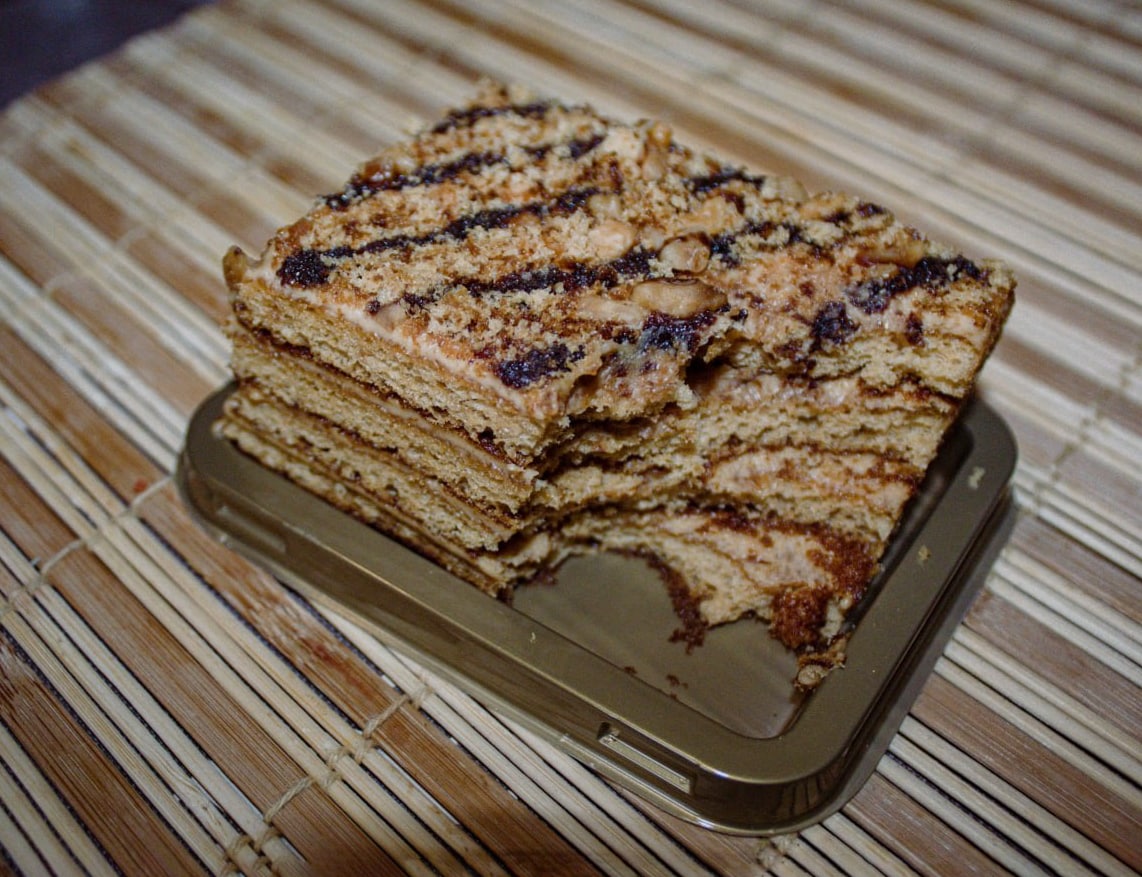|
Miodownik (cake)
In Polish cuisine, miodownik (from Polish language, Polish ''miód'' — 'honey'; German language, German: ''Honigkuchen'') or stefanka is a type of layer cake flavoured with Honey cake, honey, similar to cakes in other Slavic cuisines such as the Russian ''medovik'' and Czech ''medovnik''. It is broadly considered a type of Gingerbread, piernik, meaning a sweet and/or spiced confectionery good. The recipe for miodownik originates from Galicia (Eastern Europe), Galicia (Southeastern Poland) and Poland, Central Poland. The cake is prepared similarly to sponge cake, which is topped with honey that is melted and then cooled down along with other sugary ingredients. Once the mass of prepared dough is poured onto a baking sheet, it is baked at a temperature of 200°C for around 40 minutes. This recipe found its way into the Jewish cuisine, cuisine of Polish Jews under the name chonek łejkech or chonek (from German language, German ''honig'' — 'honey'), together with '':pl:Cuker łej ... [...More Info...] [...Related Items...] OR: [Wikipedia] [Google] [Baidu] |
Poznań
Poznań () is a city on the River Warta in west-central Poland, within the Greater Poland region. The city is an important cultural and business centre, and one of Poland's most populous regions with many regional customs such as Saint John's Fair (''Jarmark Świętojański''), traditional Saint Martin's croissants and a local dialect. Among its most important heritage sites are the Renaissance Old Town, Town Hall and Gothic Cathedral. Poznań is the fifth-largest and one of the oldest cities in Poland. As of 2021, the city's population is 529,410, while the Poznań metropolitan area (''Metropolia Poznań'') comprising Poznań County and several other communities is inhabited by over 1.1 million people. It is one of four historical capitals of medieval Poland and the ancient capital of the Greater Poland region, currently the administrative capital of the province called Greater Poland Voivodeship. Poznań is a center of trade, sports, education, technology and touri ... [...More Info...] [...Related Items...] OR: [Wikipedia] [Google] [Baidu] |
Honey
Honey is a sweet and viscous substance made by several bees, the best-known of which are honey bees. Honey is made and stored to nourish bee colonies. Bees produce honey by gathering and then refining the sugary secretions of plants (primarily floral nectar) or the secretions of other insects, like the honeydew of aphids. This refinement takes place both within individual bees, through regurgitation and enzymatic activity, as well as during storage in the hive, through water evaporation that concentrates the honey's sugars until it is thick and viscous. Honey bees stockpile honey in the hive. Within the hive is a structure made from wax called honeycomb. The honeycomb is made up of hundreds or thousands of hexagonal cells, into which the bees regurgitate honey for storage. Other honey-producing species of bee store the substance in different structures, such as the pots made of wax and resin used by the stingless bee. Honey for human consumption is collected from wild ... [...More Info...] [...Related Items...] OR: [Wikipedia] [Google] [Baidu] |
Polish Desserts
Polish may refer to: * Anything from or related to Poland, a country in Europe * Polish language * Poles, people from Poland or of Polish descent * Polish chicken *Polish brothers (Mark Polish and Michael Polish, born 1970), American twin screenwriters Polish may refer to: * Polishing, the process of creating a smooth and shiny surface by rubbing or chemical action ** French polishing, polishing wood to a high gloss finish * Nail polish * Shoe polish * Polish (screenwriting), improving a script in smaller ways than in a rewrite See also * * * Polonaise (other) {{Disambiguation, surname Language and nationality disambiguation pages ... [...More Info...] [...Related Items...] OR: [Wikipedia] [Google] [Baidu] |
Medivnyk
Medivnyk or medovyk ( uk, медівник) іs a Ukrainian honey cake. According to food writer Marianna Dushar, medivnyk is a fundamental dessert of Lviv regional cuisine. Polish-Ukrainian food writer Viktoria Popin classifies medivnyk as a ''keks'' (a type of fruitcake). Medivnyk typically includes spices, nuts and raisins. Buckwheat honey is preferred to give the cake its distinctive taste. Apart from the spongy cake, ''medivnyk'' in Ukrainian can also mean ''prianyk'', a hard honey cookie. See also * Miodownik * Medovik Medovik (russian: медови́к (medovik), ukr, медівник (medivnyk), from мёд/мед — 'honey') is a layer cake popular in countries of the former Soviet Union. The identifying ingredients are honey and smetana (sour cream) or ... References {{Ukraine-cuisine-stub Ukrainian cakes Honey cakes ... [...More Info...] [...Related Items...] OR: [Wikipedia] [Google] [Baidu] |
Medovik
Medovik (russian: медови́к (medovik), ukr, медівник (medivnyk), from мёд/мед — 'honey') is a layer cake popular in countries of the former Soviet Union. The identifying ingredients are honey and smetana (sour cream) or condensed milk. It is a dessert which is known for its lengthy preparation time. It consists of layers of sponge cake with a cream filling and is often covered with nuts or crumbs made from leftover cake. While the thin layers harden shortly after coming out of the oven, the moisture of the filling softens it again over time. There are many recipes and variations of this cake, but, the main ingredient is honey, giving it the characteristic taste and flavor. Origins According to Russian tradition, the cake was created in the 19th century in the Russian Empire by a young chef who sought to impress Empress Elizabeth Alexeievna, wife of Alexander I. Empress Elizabeth could not stand honey, and any dish made with it drove her mad. One day, h ... [...More Info...] [...Related Items...] OR: [Wikipedia] [Google] [Baidu] |
List Of Polish Dishes
This is a list of dishes found in Polish cuisine. Soups * ''Barszcz'' - its strictly vegetarian version is the first course during the Christmas Eve feast, served with ''uszka'' (tiny ear-shaped dumplings) with mushroom filling (sauerkraut can be used as well, depending on the family tradition). * ''Barszcz biały'' - sour rye and pork broth with cubed boiled pork, kielbasa, ham, hard boiled egg, and dried breads (rye, pumpernickel) * ''Chłodnik'' - cold soup made of soured milk, young beet leaves, beets, cucumbers and chopped fresh dill * '' Czernina'' - duck blood soup * ''Flaki'' or ''flaczki'' - beef or pork guts tripe stew with marjoram The word “Flaki” means guts. In some areas it is made out of a cow's stomach which is cut in stripes. * '' Grochówka'' - pea and/or lentil soup * ''Kapuśniak'' - cabbage/sauerkraut soup * ''Kartoflanka'' - potato soup * '' Kiszczonka'' - traditional Wielkopolska cuisine, consists of black pudding, flour, milk and spices. * ''Krupn ... [...More Info...] [...Related Items...] OR: [Wikipedia] [Google] [Baidu] |
Wedding Reception
A wedding reception is a party usually held after the completion of a marriage ceremony as hospitality for those who have attended the wedding, hence the name reception: the couple ''receive'' society, in the form of family and friends, for the first time as a married couple. Hosts provide their choice of food and drink, although a wedding cake is popular. Entertaining guests after a wedding ceremony is traditional in most societies, and can last anywhere from half an hour to many hours or even days. Most wedding receptions are made in the evening for dinner; however, the couple may opt for a luncheon, brunch, or even afternoon tea. Ultimately the married couple chooses the details and location of the reception. In some cultures, separate wedding celebrations are held for the bride's and groom's families. Before receptions – a social event that is structured around a receiving line, and usually held in the afternoon, with only light refreshments – became popular, wedding ... [...More Info...] [...Related Items...] OR: [Wikipedia] [Google] [Baidu] |
Polish Jews
The history of the Jews in Poland dates back at least 1,000 years. For centuries, Poland was home to the largest and most significant Ashkenazi Jewish community in the world. Poland was a principal center of Jewish culture, because of the long period of statutory religious tolerance and social autonomy which ended after the Partitions of Poland in the 18th century. During World War II there was a nearly complete genocidal destruction of the Polish Jewish community by Nazi Germany and its collaborators of various nationalities, during the German occupation of Poland between 1939 and 1945, called the Holocaust. Since the fall of communism in Poland, there has been a renewed interest in Jewish culture, featuring an annual Jewish Culture Festival, new study programs at Polish secondary schools and universities, and the opening of Warsaw's Museum of the History of Polish Jews. From the founding of the Kingdom of Poland in 1025 until the early years of the Polish–Lithuanian Comm ... [...More Info...] [...Related Items...] OR: [Wikipedia] [Google] [Baidu] |
Jewish Cuisine
Jewish cuisine refers to the worldwide cooking traditions of the Jewish people. During its evolution over the course of many centuries, it has been shaped by Jewish dietary laws (''kashrut''), Jewish festivals and holidays, and traditions centred around Shabbat. Jewish cuisine is influenced by the economics, agriculture, and culinary traditions of the many countries where Jewish communities have settled and varies widely throughout the entire world. The history of Jewish cuisine begins with the cuisine of the ancient Israelites. As the Jewish diaspora grew, different styles of Jewish cooking developed. The distinctive styles in Jewish cuisine vary by each community across the Ashkenazi, Sephardi, and Mizrahi diaspora groupings; there are also notable dishes within the culinary traditions of the stand-alone significant Jewish diaspora communities from Greece, Iran, and Yemen. Since the establishment of the State of Israel in 1948, and particularly since the late 1970s, a nas ... [...More Info...] [...Related Items...] OR: [Wikipedia] [Google] [Baidu] |
Sugar
Sugar is the generic name for sweet-tasting, soluble carbohydrates, many of which are used in food. Simple sugars, also called monosaccharides, include glucose, fructose, and galactose. Compound sugars, also called disaccharides or double sugars, are molecules made of two bonded monosaccharides; common examples are sucrose (glucose + fructose), lactose (glucose + galactose), and maltose (two molecules of glucose). White sugar is a refined form of sucrose. In the body, compound sugars are hydrolysed into simple sugars. Longer chains of monosaccharides (>2) are not regarded as sugars, and are called oligosaccharides or polysaccharides. Starch is a glucose polymer found in plants, the most abundant source of energy in human food. Some other chemical substances, such as glycerol and sugar alcohols, may have a sweet taste, but are not classified as sugar. Sugars are found in the tissues of most plants. Honey and fruits are abundant natural sources of simple sugars. Suc ... [...More Info...] [...Related Items...] OR: [Wikipedia] [Google] [Baidu] |






